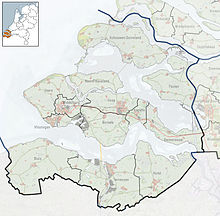
Back Belagerung von Hulst (1596) German Asedio de Hulst (1596) Spanish Assedio di Hulst (1596) Italian Beleg van Hulst (1596) Dutch
| Siege of Hulst (1596) | |||||||
|---|---|---|---|---|---|---|---|
| Part of the Eighty Years' War & the Anglo–Spanish War | |||||||
 Engraving of the siege of Hulst of 1596 by Frans Hogenberg – collection Rijksmuseum Amsterdam | |||||||
| |||||||
| Belligerents | |||||||
|
|
| ||||||
| Commanders and leaders | |||||||
|
|
| ||||||
| Strength | |||||||
|
Hulst: 3,700[4][5] Relief forces: 7,000[6] | 12,000 to 15,000[7] | ||||||
| Casualties and losses | |||||||
|
500 killed or wounded[8] 3,000 surrendered[8] |
1,300 to 2,000 dead[2][9] 800 to 3,000 wounded[2][5][10] | ||||||
Location within Zeeland | |||||||
The siege of Hulst of 1596 took place between mid-July and August 18, 1596, at the city of Hulst, Province of Zeeland, Low Countries (present-day the Netherlands), during the Eighty Years' War, the Anglo-Spanish War (1585–1604).[1][2][6][11] The siege was won by the Spanish forces of the Archduke of Austria. After a short siege, during which Maurice of Orange launched a failed attempt to relieve the city, the garrison of Dutch and English troops fell into Spanish hands on August 18, 1596.[10][12]
- ^ a b Olaf van Nimwegen. The Dutch Army and the Military Revolutions 1588–1688. p.164
- ^ a b c d Giménez Martín p.232
- ^ Edmundson p 94
- ^ Giménez Martín p.231
- ^ a b Robert Fruin p.303
- ^ a b van Nimwegen pp 163–64
- ^ Motley, John Lothrop. The Rise of the Dutch Republic, Entire 1566–74. pp. 394–95.
- ^ a b Ward, Adolphus William (1918). Cambridge Modern History, Volume 3. Macmillan. pp. 626–28.
Cambridge Modern History, Volume 3.
- ^ .Carlos Coloma: 1566-1637, espada y pluma de los tercios. Guill Ortega p.93
- ^ a b Charles Maurice Davies (1851). The History of Holland and the Dutch nation: from the beginning of the tenth century to the end of the eighteenth. G. Willis. pp. 348–49.
- ^ Marjolein 't Hart p.22
- ^ Wernham pp 81–82

